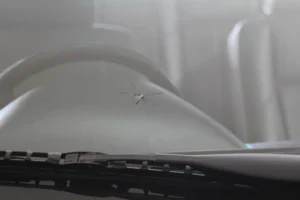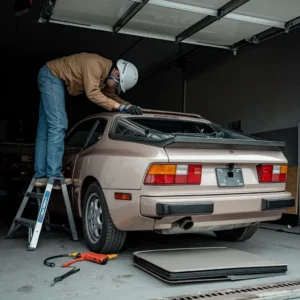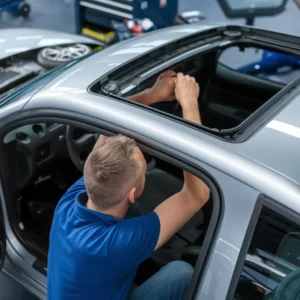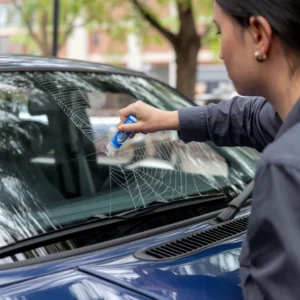Windshield Chip Repair | Quick Fixes for a Safer Drive Windshield chip repair is crucial...
Cracked and Shattered| Navigating Windshield Hail Damage
Windshield hail damage refers to the destruction or impairment caused to a vehicle’s windshield due to hailstorms. Hail, typically small balls of ice formed during thunderstorms, can vary in size from small pellets to large stones, posing a significant threat to the integrity of a vehicle’s glass surfaces, including windshields. When hail strikes a windshield, it can result in a range of damage, from minor cracks and chips to more severe fractures and shattering.
Understanding Windshield Hail Damage
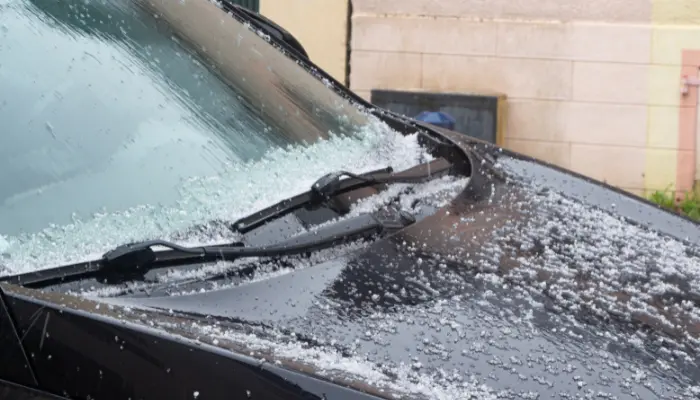
Causes of Windshield Hail Damage:
Windshield hail damage occurs when hailstones, typically small balls of ice formed during thunderstorms, impact the surface of a vehicle’s windshield. These hailstones vary in size, ranging from small pellets to larger chunks, and their impact velocity can be substantial depending on the force of the storm. The damage is primarily caused by the kinetic energy transferred from the hailstone to the windshield upon impact.
Common Signs and Symptoms:
Cracks: One of the most common signs of windshield hail damage is the appearance of cracks on the glass surface. These cracks can vary in length and depth, depending on the size and velocity of the hailstones.
Chips: Hailstones can also cause smaller chips or pits on the windshield surface. These may appear as small indentations or marks, often concentrated in areas where the hail impact was most severe.
Shattered Glass: In extreme cases of hail damage, the windshield may shatter completely, posing a significant safety risk to the vehicle occupants.
Distorted Visibility: Even minor hail damage can cause distortion or obstruction in the driver’s field of vision, compromising safety while driving.
Impact on Vehicle Safety and Functionality:
Compromised Structural Integrity: Windshield hail damage weakens the structural integrity of the glass, making it more susceptible to further damage from environmental factors or impacts.
Reduced Protection: A compromised windshield provides less protection to the vehicle occupants in the event of a collision or rollover accident, increasing the risk of injury.
Impaired Visibility: Cracks, chips, or distortions caused by hail damage can impair the driver’s visibility, potentially leading to accidents or collisions on the road.
Legal Compliance: In many jurisdictions, driving with a damaged windshield may be considered a violation of road safety regulations, leading to fines or penalties for the vehicle owner.
How to Protect Your Vehicle from Hail Damage
Protecting your vehicle from hail damage is crucial, especially in areas prone to severe weather. Here are some strategies to safeguard your vehicle:
Parking Strategies
Covered Parking Options: Whenever possible, park your vehicle in covered parking areas such as parking garages or carports. This provides the best protection against hail damage.
Utilizing Carports or Garages: If you don’t have access to covered parking, consider installing a carport or using a garage to shield your vehicle from hailstorms.
Hail Protection Covers: Invest in hail protection covers specifically designed to withstand hail impact. These covers act as an extra layer of defense for your vehicle.
Protective Measures
Investing in Hail-Proof Car Covers: Purchase specialized hail-proof car covers made from durable materials that can resist hail damage. These covers are designed to absorb impact and protect your vehicle’s exterior.
Installing Impact-Resistant Windshields: Consider upgrading to impact-resistant windshields, which are less likely to shatter upon hail impact. This can prevent costly windshield replacements.
Using Soft Blankets or Foam Padding as Shields: In the absence of specialized covers, place soft blankets or foam padding on your vehicle’s exterior during hailstorms. While not as effective as purpose-built covers, they can provide some level of protection against hailstones.
Monitoring Weather Alerts and Taking Precautionary Measures: Stay informed about weather forecasts and pay attention to hailstorm warnings. If severe weather is predicted, take proactive measures such as parking your vehicle in a covered area or using protective covers to minimize potential damage.
Windshield Hail Damage Repair Options
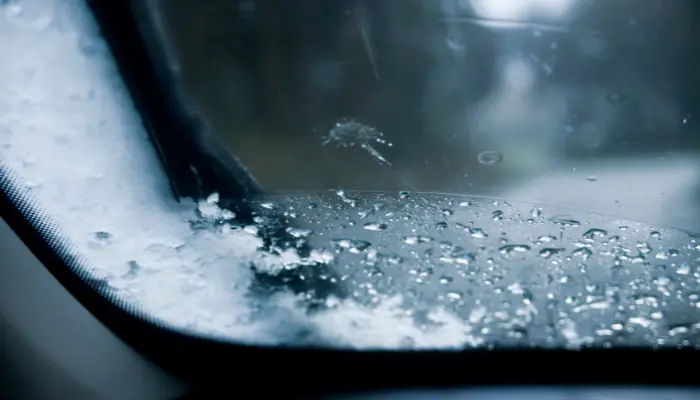
Assessing the Extent of Damage:
Before deciding on repair options, carefully assess the extent of the damage to your windshield. Determine the number, size, and severity of chips or cracks.
DIY Repair Techniques (if applicable):
Using Windshield Repair Kits:
Windshield repair kits are available in the market and can be used for small chips and cracks. These kits typically include resin and tools for filling the damaged area. Follow the instructions carefully for best results.
Filling Minor Chips and Cracks:
For minor damage, you can attempt to fill the chips or cracks using specialized windshield repair resin. Clean the area thoroughly and apply the resin according to the instructions provided with the product.
Professional Repair Services:
Repair Cost Factors:
The cost of professional repair services depends on various factors including the extent of damage, type of vehicle, location, and the repair shop’s pricing policy. Expect costs to vary, with more severe damage requiring more extensive repairs and thus costing more. If you want professional guidance then Reliable Auto Glass is best in business.
Finding Reputable Repair Shops:
Research local repair shops and look for ones with good reputations for quality workmanship and customer service. Ask for recommendations from friends, family, or your insurance company. Check online reviews and ratings to gauge the reliability and trustworthiness of a repair shop.
Insurance Coverage and Claims Process:
Check if your auto insurance policy covers windshield damage repair. Most comprehensive insurance policies include coverage for windshield repairs, sometimes with no deductible. Contact your insurance provider to understand your coverage and initiate the claims process if necessary. Be prepared to provide details about the damage and possibly get an inspection before repairs are approved.
Conclusion
Windshield hail damage poses a significant risk to vehicle safety and functionality. It can compromise visibility, weaken the structural integrity of the windshield, and increase the likelihood of further damage or accidents. Prompt repair or replacement is essential to ensure the safety of drivers and passengers on the road. Feel free to contact us for any type of services or query like windshield hail damage.
FAQs
What Is Windshield Hail Damage?
Windshield hail damage refers to any cracks, chips, or dents caused by hailstones striking the windshield of a vehicle.
How Does Hail Damage Occur To Windshields?
Hail damage occurs when hailstones, typically ranging in size from small pellets to large chunks of ice, impact the windshield with enough force to cause cracks, chips, or other forms of damage.
What Are The Signs Of Windshield Hail Damage?
Signs of windshield hail damage include visible cracks, chips, or dents on the windshield surface, as well as spider-web patterns or localized impact marks.
Can Windshield Hail Damage Be Repaired?
In many cases, windshield hail damage can be repaired using techniques such as filling chips with resin or applying a protective film. However, severe damage may require windshield replacement.
Is Windshield Hail Damage Covered By Insurance?
Whether windshield hail damage is covered by insurance depends on the specific terms of your policy. Comprehensive auto insurance typically covers damage from natural disasters, including hailstorms.
Our Services
Our Latest Blogs
1986 Porsche 944 Sunroof Replacement | Expert Installation
1986 Porsche 944 Sunroof Replacement | Expert Installation 1986 Porsche 944 sunroof replacement is an...
Sunroof Seal Replacement | Say Goodbye to Water Leaks
Sunroof Seal Replacement | Say Goodbye to Water Leaks Sunroof seal replacement is essential for...
How to Stop My Windshield Crack from Spreading
How to Stop My Windshield Crack from Spreading How to stop my windshield crack from...


